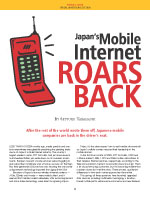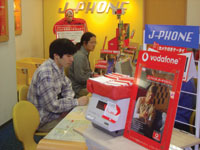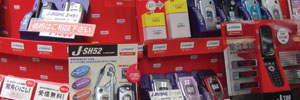Japan's Mobile Internet Roars Back
Back to Contents of Issue: July 2003
|
|
|
|
by Setsuko Takahashi |
|
 LESS THAN A DOZEN months ago, media pundits and analysts everywhere were gleefully predicting the pending irrelevance of Japan's mobile Internet industry. The country's largest wireless carrier, NTT DoCoMo, had just announced a multi-hundred billion yen write-down on its overseas investments, Europe's nascent i-mode services were struggling to gain subscriber mindshare and, at home, success on the then-two third-generation (3G) services was favoring the one carrier using network technology imported from (gasp!) the USA. LESS THAN A DOZEN months ago, media pundits and analysts everywhere were gleefully predicting the pending irrelevance of Japan's mobile Internet industry. The country's largest wireless carrier, NTT DoCoMo, had just announced a multi-hundred billion yen write-down on its overseas investments, Europe's nascent i-mode services were struggling to gain subscriber mindshare and, at home, success on the then-two third-generation (3G) services was favoring the one carrier using network technology imported from (gasp!) the USA.
Boosters of Japan's famous wireless Internet systems -- J-Sky, EZweb and i-mode -- were notably silent, and it seemed that mobile markets elsewhere, after extracting lessons and some token technology, were intent on ignoring Japan.
Today, it's the doomsayers' turn to eat humble okonomiyaki as Japan's cellular carriers reassert their leadership in the mobile domain.
In the first four months of 2003, NTT DoCoMo, KDDI and J-Phone added 1.899, 1.072 and 0.845 million subscribers to their wireless Internet services, respectively, according to the Telecommunication Carrier's Association (www.tca.or.jp). That's a lot of packet-using customers, but it's becoming evident that numbers alone don't tell the story: There are real, qualitative differences in how each carrier approaches the market.
This spring, all three operators here launched upgraded data services including multimedia messaging, a location-based mobile portal, enhanced e-commerce and new features such as global voice and data roaming.
This year has also seen Japan's handset makers commercialize camera phones boasting new, digital-camera-equivalent CCD cameras, removable memory and video mail capabilities. Among these, Sharp, Toshiba, Sanyo, NEC, Mitsubishi Electric and Matsushita are all competing for lead market position while eyeing overseas sales possibilities.
Sharp, which created the world's first successful camera-enabled handset, the J-SH04, for J-Phone in November 2000, has moved up several ranks to become a top-tier supplier to all three large domestic carriers. The firm has parlayed experience with J-Phone, the domestic operating company of UK-based Vodafone, into success outside Japan and started selling its camera-equipped GX-10 model, compatible with Vodafone's live! data service, in Europe in October 2002. live! now has over 1 million subscribers in more than 10 countries, with expansion planned for Egypt, Australia and New Zealand later this year.
In May this year Sharp launched the world's first megapixel-class camera phone, the J-SH53, offering mobile photo imaging on par with traditional low-end digital cameras.
J-Phone's launch of its third-generation "Vodafone Global Standard" service (using the newest revision of the globally accepted W-CDMA, or Wideband-Code Division Multiple Access 3G standard) has served to address the glaring gap in domestic roaming services. Enhanced roaming didn't arise, as might be expected, from NTT DoCoMo's massive overseas deployment in 2000-01. "This is the world's first 3G W-CDMA service based on international standards and will ensure compatibility with global networks," explains a J-Phone spokesperson.
Now that all three major Japanese carriers have launched their 3G services (NTT DoCoMo launched their domestic-only W-CDMA system in October 2001 and KDDI opened their CDMA 1X service in April last year), mobile dialers here are also getting their first taste of cellular voice and data services segmented by demographics. In the previous 2G-only era, carriers were hard-pressed to offer any variation in services between youth, adult and business segments.
It's the doomsayers' turn to eat humble
Specific wireless Internet service offerings can also be highly differentiated. J-Phone's now-famous "Sha-mail" picture messaging service -- available on all new 2G handsets -- provides features that are hard to find on other networks. "With regards to picture messaging, Sha-mail's ease of use is a big differentiator. Users can send photos as mail attachments -- there's no requirement to have the recipient access a coded URL," explains a PR spokesperson.
2003 is shaping up as a banner year for Japan's complex "ecosystem" of third-party content, application and service providers as vendors refine and improve their services. Although sale of digital content such as ring tones, Java games and wallpaper images remains the core of the mobile Internet, one of the key developments on all three platforms has been the creation of sophisticated and effective mobile marketing systems.
These systems -- largely managed by the carriers and their lead advertising partners -- include opt-in mail messaging, special advertising-supported "advertorial" content sites, independent editorial reviews of new services updated weekly and tight integration with third-party contest and campaign marketing efforts.
Consumer-facing vendors such as candy makers (Morinaga), clothing retailers (Jeans Mate discount chain), soft drink suppliers (Kirin) and entertainment promotion companies (Tsutaya Online) have all successfully made use of mobile channels to market, promote and sell their products. But with some 50,000-plus unofficial i-mode sites as well as thousands more official content providers on J-Sky, EZweb and i-mode, there's still plenty of room for marketing innovation, and in some cases being smaller enhances a company's competitive edge.
The firm offers content and game development, systems integration and localization, e-marketing/mail marketing and e-payment services, and has expertise covering both traditional mobile Web technologies (such as the cHTML and WML mini-Web page markup languages) as well as the newest Java and multimedia Flash environments.
Thomas Jenkins, PAC ET principal at their Ebisu offices, also points to the firm's "RapidReach" eBusiness suite as one of their strengths. RapidReach combines the mCMS Mobile Content Management Platform, the PEP eMarketing platform and mform, a mobile document management system that allows companies to utilize their mobile sites to deliver document-based messaging.
The future will be evolutionary "Our team has been here in the mobile space since its beginnings," say Jenkins, "and if that means creating award-winning mobile sites like we did with FlyingColor Group in 2001 for Heineken or building a cutting-edge mobile gaming system like we are doing now with MPM Technologies, we intend to provide the best solution in the most cost-effective manner." Clearly, the firm's ability to service both clients' e-marketing and technical development needs makes PAC ET's value proposition a strong one.
This year also promises the commercialization of utterly new, 3G-based mobile Internet services that exist nowhere else. These include enhanced video conferencing, dual-mode terminals, innovative form factors straight out of Sci-Fi and the creation of vehicle-based "telematic" systems.
Minato-ku-based Mobilecast Inc. was founded in 2002 by Eiji Akaike. Mobilecast is also supported by Omron, a key manufacturer of control systems and other technology.
Mobilecast plans to create what is arguably the world's first open-platform mobile content delivery system targeting in-car terminals, based on KDDI's fast and popular (over 7.5 million users in April) CDMA 2000 1X third-generation network.
The firm refers to its telematics service as the first true "nomadic communications" system offering entertainment content, driver support, safety and security from any location. Mobilecast's system is called "nomadic" due to its anywhere, anytime accessibility. It will deliver road and traffic information, satellite navigation data, weather, radio broadcast, visual content, audio entertainment, remote diagnosis, remote maintenance check and roadside emergency notification and response services to consumers' cars. Mobilecast will also enable digital fleet management and other transportation enterprise services.
As an "open platform," similar to the existing J-Sky, EZweb and i-mode systems themselves, Mobilecast's system will combine a content creator community of third-party providers, a Mobilecast Telematics broadcast service center and an in-car TAS (Telematics Application Server) terminal. Mobilecast will enable third-party providers to deliver entertainment, services and e-commerce straight to cars. "We call it the advent of the 'entertainment car,'" says CEO Akaike, pointing to the ability for a third-party company like a car maker or a consumer brand owner to create and deliver their own branded services via Mobilecast. "We're selling a lifestyle," he adds, clearly cognizant of the powerful, wallet-opening techniques used for so long by product and service providers in Japan's consumer space. "We are a new media in between broadcasting and communications."
After being demonstrated at the October Tokyo Motor Show, the system is scheduled for launch in the fall of 2003 with an initial suite of data services operating on a simple terminal that will be expanded in 2004 with an in-car terminal taking advantage of KDDI's 2.4-Mbps CDMA 2000 1X EV-DO network, due for rollout by the end of 2003.
Like PAC ET, Mobilecast is also planning to extend its service to include the new WLAN network technology. Akaike describes a "hotspot" version of Mobilecast wherein garages, chain restaurants or indeed anyone with a parking lot can install a "data vending machine." A Mobilecast-equipped vehicle need only park nearby (WLAN allows ranges of up to a few hundred meters), pay a fee and then download video, audio or other rich-media contents for later on-the-road enjoyment.
The firm expects to see 1 million Mobilecast-equipped vehicles on the road by 2006, and is also investigating expansion to the US and China in view of those markets' use of CDMA 2000 1X and 1X EV-DO networks similar to Japan's.
But the future will be evolutionary rather than revolutionary. "We do not see a 'killer app' coming from 3G," said one J-Phone press representative. "Rather, with 3G, we'll see an evolution of the already popular 2G data services like ring tones, picture messaging, video messaging and mobile content. And with our service offerings, 3G users will be able to enjoy 'powered-up' versions of these services not only in Japan, but in almost any other part of the world." @
DIRECTORY
When calling from outside Japan please dial the country code (81) first, then 3 for Tokyo (omitting the 0), followed by the number.
J-PHONE Co., Ltd.
Mobilecast Inc.
Pacific Enabling Technologies (PAC ET)
|
|
Note: The function "email this page" is currently not supported for this page.


 In addition to providing high-quality voice communications on par with fixed-line, downlink packet data speeds of up to 384 kbps and 64-kbps circuit-switched videotelephony in Japan, Vodafone Global Standard users will also get unparalleled global connectivity with access to voice and short messaging service (SMS) roaming on GSM networks in over 70 countries by June 2003.
In addition to providing high-quality voice communications on par with fixed-line, downlink packet data speeds of up to 384 kbps and 64-kbps circuit-switched videotelephony in Japan, Vodafone Global Standard users will also get unparalleled global connectivity with access to voice and short messaging service (SMS) roaming on GSM networks in over 70 countries by June 2003.
 Combined, these three systems target the key elements of all successful mobile marketing strategies: content development on the three lead carriers' wireless Internet services and mail marketing that allows an advertiser to manage, segment, target, broadcast and track mobile messaging campaigns. "For companies that are looking for a jump-start in the mobile market, the RapidReach Suite is a set of platforms that allows our clients to enter the mobile market with total ease and efficiency," says Jenkins.
Combined, these three systems target the key elements of all successful mobile marketing strategies: content development on the three lead carriers' wireless Internet services and mail marketing that allows an advertiser to manage, segment, target, broadcast and track mobile messaging campaigns. "For companies that are looking for a jump-start in the mobile market, the RapidReach Suite is a set of platforms that allows our clients to enter the mobile market with total ease and efficiency," says Jenkins.






